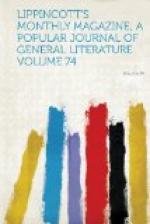[Footnote 3: Prize Essay on Portugal, London, 1854.]
[Footnote 4: Parliamentary Papers, London, 1870.]
[Footnote 5: Estudos Estatisticos, hygienicos e administrativas sobre as doencas e a mortalidade do exercito Portuguez, etc., by Dr. Jose Antonio Marques, Lisbon, 1862.]
[Footnote 6: Doria, p. 184.]
[Footnote 7: The Registrar-General of England.]
[Footnote 8: L.A. Rebello da Silva (minister of marine), Economia. Rural, Lisbon, 1868.]
The utmost area of land which the average Portuguese peasant can cultivate is two and a half acres: in the United States the average of cultivated land per laborer is over thirty-two acres; on prairie-land sixty acres is not uncommon. Forrester writes: “In the Alto Douro, the richest portion of the kingdom, the villages are formed of wretched hovels with unglazed windows and without chimneys. Instead of bread or the ordinary necessaries of life, one finds only filth, wretchedness and death. Emigration is the one thought of the people.”
Now for the moral, intellectual and physical results of the destitution thus evinced. The work entitled Voyage du Duc du Chatelet en Portugal, although usually quoted under this title, was really written by M. Comartin, a royalist of La Vendee, and written during the French Revolution. If it had any bias at all, that bias was all in favor of Portugal, yet this is his description of her people: “Il est, je pense, peu de peuple plus laid que celui de Portugal. Il est petit, basane, mal conforme. L’interieur repond, en general, assez a cette repoussante envelope, surtout a Lisbonne, ou les hommes




